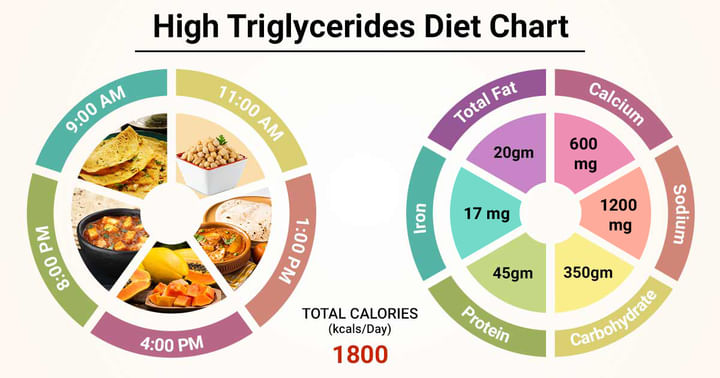Diet Chart For High Triglyceride Patients
Last Updated: Aug 24, 2020
About Triglyceride Diet
High triglycerides diet is required food items lower the levels of excessive triglycerides, a type of fat, in the body. After eating, the body converts the calories that it doesn’t need into triglycerides and stores them as a future energy source. Triglycerides are integral to a body’s proper functioning, however, excessive amounts of them can make one more prone to the risk of heart diseases.
Following are some pointers from the high triglycerides diet plan to reduce the amount of triglycerides in the body:
- Limit your sugar intake – Extra sugar gets converted into triglycerides and gets stored in the fat cells increasing the scope of heart diseases. Therefore, minimizing sugar consumption by avoiding fruit juices, sugar-sweetened beverages and soda and instead replacing them with water is known to reduce triglyceride levels in the blood.
- Reduce saturated and trans fats – Saturated and trans fat is the fat commonly found in fast foods, processed foods, packaged foods, and baked foods to increase their shelf life. Avoiding the consumption of the aforementioned categories of foods and replacing them with mono and polyunsaturated fats, such as those found in olive oil, avocados and nuts, can significantly lower high triglycerides levels in the body and reduce the chances of heart diseases.
- High fibre diet – Fibre is found in fruits, vegetables and whole grains. Other healthy sources of fibre include nuts, cereals and pulses. A high fibre diet plan helps in decreasing the absorption of fat and sugar in the small intestine thereby reducing triglyceride levels.
You can follow this diet meal plan to manage triglycerides, check out the list of foods that lower triglycerides. This 7-day diet plan helps to lower triglyceride level, and food items mentioned in the diet chart, easily available in your local markets. We also listed out some food items that need to be avoided with high triglyceride level.
This Indian diet plan to control triglycerides created after consultation with experienced dietitations. Along with the list of food items you need some changes in your lifestyle which are also mentioned in this diet plan and helpful in controlling it.
Best Diet Plan to Lower Triglycerides
| Sunday | |
| Breakfast (8:00-8:30AM) | Basan cheela 2+ 1 tbs green chutney + 1 cup skim milk |
| Mid-Meal (11:00-11:30AM) | 1 cup boilled channa salad |
| Lunch (2:00-2:30PM) | 1/2 cup rice+ 2 chapatti + Soya chunk curry 1/2 cup+ Ladies finger subji 1/2 cup + salad |
| Evening (4:00-4:30PM) | 1 cup papaya |
| Dinner (8:00-8:30PM) | 2 Roti / chappathi.+ mattar paneer subji 1/2 cup. |
| Monday | |
| Breakfast (8:00-8:30AM) | Mix veg Upma 1 cup+ 1 skim milk |
| Mid-Meal (11:00-11:30AM) | 1 cup mixed fruit salad |
| Lunch (2:00-2:30PM) | 3 Chappati+ 1/2 cup cluster beans subji+ Fish curry(100g fish) 1/2 cup + salad |
| Evening (4:00-4:30PM) | 1 cup tea/ coffee + 2 biscuits ( Nutrichoice or Digestive or Oatmeal.) |
| Dinner (8:00-8:30PM) | 2 Roti / chappathi+Ridge guard subji 1/2 cup. |
| Tuesday | |
| Breakfast (8:00-8:30AM) | Vegetable Oats Upma 1 cup+ 1 cup skim milk. |
| Mid-Meal (11:00-11:30AM) | 1 sliced cucumber and carrot salad |
| Lunch (2:00-2:30PM) | 1/2 cup rice + 2 chapatti+1/2 cup Kidney beans curry+ Snake guard subji 1/2 cup + salad |
| Evening (4:00-4:30PM) | 1 cup moong dal sprouts salad + 1 cup lemon water |
| Dinner (8:00-8:30PM) | 2 Roti/ chapati+ 1/2 cup mix veg curry |
| Wednesday | |
| Breakfast (8:00-8:30AM) | 1 Slice toasted brown bread + 2 Boiled egg white + 1 cup low fat milk. |
| Mid-Meal (11:00-11:30AM) | 1 cup moong dal sprout salad |
| Lunch (2:00-2:30PM) | Veg pulav rice with soy chunks 1 cup+ 1/2 cup tomato curry + 1 cup Low fat curd + salad |
| Evening (4:00-4:30PM) | 1 cup watermelon |
| Dinner (8:00-8:30PM) | 2 roti/ Chapathi+ Ladies finger subji 1/2 cup. |
| Thursday | |
| Breakfast (8:00-8:30AM) | 3 Idli + Sambhar 1 cup + 1 table spoon Green chutney/ Tomato Chutney |
| Mid-Meal (11:00-11:30AM) | 1 sliced cucumber and carrot salad |
| Lunch (2:00-2:30PM) | 3 Roti+1/2 cup salad + Fish curry ( 100 gm fish)+ green chutney |
| Evening (4:00-4:30PM) | 1 cup tea/ coffee + 2 biscuits ( Nutrichoice or Digestive or Oatmeal.) |
| Dinner (8:00-8:30PM) | 2 Roti / chappathi.+ Tomato subji 1/2 cup. |
| Friday | |
| Breakfast (8:00-8:30AM) | 2 paneer stuffed chapatti + 1 cup low fat milk |
| Mid-Meal (11:00-11:30AM) | 1 cup mixed fruit salad |
| Lunch (2:00-2:30PM) | 1/2 cup rice+ 2 chapatti + 1 cup Dal+ Palak subji 1/2 cup+ salad |
| Evening (4:00-4:30PM) | 1 cup moong dal sprouts salad + 1 cup lemon water |
| Dinner (8:00-8:30PM) | 2 Roti / chappathi.+ paneer stuffed capsicum subji 1/2 cup. |
| Saturday | |
| Breakfast (8:00-8:30AM) | Methi Paratha 2+ 1 cup low fat milk |
| Mid-Meal (11:00-11:30AM) | 1 cup boilled channa salad |
| Lunch (2:00-2:30PM) | 1 cup rice+ chicken curry 200 gm chicken+ 1 cup cucumber salad. |
| Evening (4:00-4:30PM) | 1 cup mixed fruit salad |
| Dinner (8:00-8:30PM) | 2 Roti / chappathi.+ lotus stem subji 1/2 cup. |
Triglyceride Diet Restrictions: Food Items To Limit
Since, the amount of fat molecules in blood is elevated in this situated fat intake should be restricted. Minimal use of cooking oil should be encouraged. Use of vegetable oil, olive oil, coconut oil is adviceable.
- In-take if junk foods and deep fried foods (including homemade snacks) should be totally
- Complex dairy products like butter, cheese and margerine should be avoided, as the kind of fat present in these products tends to get deposited and may contribute to the prevailing health
- In-take of ghee can be allowed, but in very small and/or less quantity (1 tsp per a day).
- Whole milk (or full fat milk) should be avoided. In place toned and/or skim milk should be used.
- In-take of animal proteins (like egg-yolk, fatty chicken, buff, beef, pork, red meat) should be avoided and it should be compensated by in-take of pulses (daal and daal products).
- In-take of processed meat products such as sausages, bacon, processed meats, hot dogs, salami, etc should always be avoided.
- In-take of refined wheat products (such as maida, macaroni, pasta, speghetti, noodles, etc) should be avoided as well.
- In-take of desserts and ice cream should be less (according to the blood sugar levels).
- Carbonated beverages, alcoholoic beverages, packaged drinks, energy drinks and fruit juices should be excluded from the daily diet.
Do's And Dont's While Following Diet Plan for Triglyceride
Do's:
- Minimal usage of oil (or fat) for cooking.
- Consumption of more vegetable proteins (pulses and fruits) as compared to animal proteins.
- Sufficient amount of physical activity (exercise and/or walking or jogging) is a necessity so as to stop the body from depositing extra fat plus the utilization of already deposited fat.
- Drink lots of water, stay hydrated. Always fresh and/or homemade fruits, juices should be taken with no added sugar.
- Eat more amount of fibres in form of vegetables, sprouts and fruits.
- Make your plate colorful with a variety of vegetables, daal, chapati and rice, and fish.
- Cod liver oil or fish oil is advisable for improving such situation as because fish oil (ecoshapentanoic acid) increases HDL in blood which in turn helps to get rid of LDL and triglycerides.
Don'ts:
- Consume two animal proteins in one day. Always divide your animal protein intake uniformly.
Food Items You Can Easily Consume to Lower Triglyceride
- Legumes : Legumes like beans, peas and lentils can help lower LDL levels and are a good source of plant-based protein.
- Nuts, Especially Almonds and Walnuts : Nuts also contain protein. They're particularly rich in L-arginine, an amino acid that helps make nitric oxide. This, in turn, helps regulate blood pressure
- Fatty Fish : Fatty fish contain high levels of omega-3 fatty acids and have been linked to a decreased risk of heart disease and stroke.
- Whole Grains, Especially Oats and Barley : Oats: They contain beta-glucan, a type of soluble fiber that helps lower cholesterol. Barley: Is also rich in beta-glucans and can help lower LDL cholesterol.
- Fruits and Berries : Fruit also contains bioactive compounds that help prevent heart disease and other chronic diseases due to their antioxidant and anti-inflammatory effects. Eating berries and grapes, which are particularly rich sources of these plant compounds, can help increase HDL cholesterol and lower LDL cholesterol.
- Dark Chocolate and Cocoa : Flavonoids in dark chocolate and cocoa can help lower blood pressure and LDL cholesterol while raising HDL cholesterol.
- Garlic : Garlic contains allicin and other plant compounds, which may help lower LDL cholesterol and reduce other heart disease risk factors.
- Soy Foods : There is some evidence that soy foods can reduce heart disease risk factors, especially in people with high cholesterol.
- Vegetables : Vegetables are high in fiber and antioxidants and low in calories, making them a heart-healthy choice. Pectin-rich vegetables also include okra, eggplants, carrots and potatoes.
- Tea : Catechins may help your heart in several ways. They help activate nitric oxide, which is important for healthy blood pressure. They also inhibit cholesterol synthesis and absorption and help prevent blood clots.
- Dark Leafy Greens : Dark leafy greens are rich in carotenoids, including lutein, which are linked to a lower risk of heart disease and stroke.
- Extra Virgin Olive Oil : Olive oil is a primary component of the heart-healthy Mediterranean diet. It has monounsaturated fatty acids and antioxidants that are good for the heart.
References
- Sadovsky R, Kris-Etherton P. Prescription omega-3-acid ethyl esters for the treatment of very high triglycerides. Postgraduate medicine. 2009 Jul 1;121(4):145-53.
- De Biase SG, Fernandes SF, Gianini RJ, Duarte JL. Vegetarian diet and cholesterol and triglycerides levels. Arquivos brasileiros de cardiologia. 2007 Jan 1;88(1):35.
- Kastelein JJ, Maki KC, Susekov A, Ezhov M, Nordestgaard BG, Machielse BN, Kling D, Davidson MH. Omega-3 free fatty acids for the treatment of severe hypertriglyceridemia: the EpanoVa fOr Lowering Very high triglyceridEs (EVOLVE) trial. Journal of clinical lipidology. 2014 Jan 1;8(1):94-106.
Table of content
Find Dietitian/Nutritionist near me
Ask a free question
Get FREE multiple opinions from Doctors



